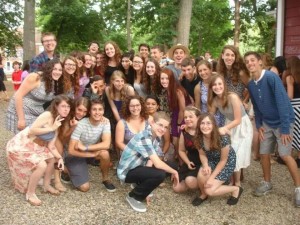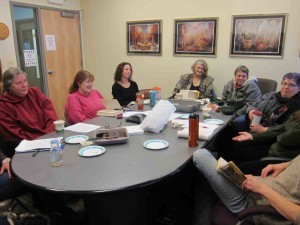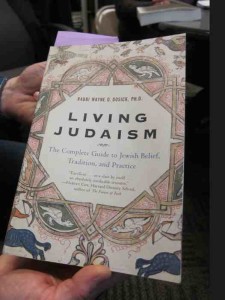This article by Rabbi Ora Nitkin-Kaner, on Vashti in the Purim story (Megillah), appeared in the March 2019 Washtenaw Jewish News.

The AARC Book group invites you to join our upcoming discussion of a part of the book Radical Judaism: Rethinking God & Tradition, by Arthur Green, on Sunday, February 24, 2019 at 9:45am, at the home of Greg Saltzman and Audrey Newell. You can read the portion we will be discussing in this PDF file. It’s the preface, intro, and first chapter of the book.
Full details, including exact location, are found here. All are welcome. Please RSVP to Greg Saltzman at gsaltzman@albion.edu if you plan to attend.
Rabbi Ora will be leading our discussion of Radical Judaiasm. This is the second year in a row that Rabbi Ora has agreed to join the book group to lead a discussion on a text of her choosing.
We asked Rabbi Ora to provide background on the Arthur Green book. Below are her thoughts.

I first met Rabbi Art Green in February 2010 – after I’d decided to attend rabbinical school, but before I’d chosen RRC and was still considering Hebrew College as an option. At the time and now, ‘Art,’ as he’s often called, was the dean of Hebrew College. I don’t recall many details from the few hours I spent there in his presence – just an overall sense of warmth, joyfulness, and curiosity coming from him. Over the past 9 years, though, I’ve had the chance to study a number of his books, including Radical Judaism, of course, but also his Guide to the Zohar and his beautiful translation of R. Yehuda Leib Alter’s writings, Language of Truth: the Torah Commentary of the Sefat Emet.
I wanted our book group to get a taste of Radical Judaism because Art Green so artfully weaves together the theological with the personal. In the Introduction, he shares how he struggled with what some might call a ‘loss of faith,’ but what he calls ‘the pillars of naïve faith [giving] way’ as he came to reject a personal God in favor of a more pantheistic sense of holiness and unity in the world. Green describes how, as a teenager, he could ‘affirm neither particular providence nor a God who governed history,’ and writes: ‘…I am not a ‘believer’ in the conventional Jewish or Western sense. I simply do not encounter God as ‘He’ is usually described in the Western religious context, a Supreme Being or Creator who exists outside or beyond the universe, who created this world as an act of personal will, and who guides and protects it.’
Art Green’s process feels very Reconstructionist to me – both the God-wrestling, and the image of God that he ultimately settles on. Many of us raised in the Jewish tradition go through, at one time or another, a similar kind of wrestling. And that’s precisely what Reconstructionism invites us to do – to not just sit (comfortably or uncomfortably) with the beliefs that have been passed down to us, but to work towards a faith tradition that feels honest, spiritually nourishing, and even transcendent.

Art Green also has a powerful vision for the role that religion can play in shaping what he calls ‘this moment of transition in planetary and human history’ – a moment in which ‘unless we take drastic steps to change our way of living, our patterns of consumption, and our most essential understanding of our relationship to the world in which we exist, we are at great risk of destroying our earthly home and rendering it a wasteland.’ Art Green sees Judaism’s deep truths as tools to help us rise to these challenges.
We look forward to seeing you on Sunday, February 24. Be sure to RSVP to Greg at the email above. Happy reading!

The creativity and collaborative nature of our Ann Arbor Reconstructionist Congregation (AARC) were on display at the joyous installation ceremony for Rabbi Ora Nitkin-Kaner on December 15, 2018.
A beautiful Chuppah was decorated with thirty colorful cloth squares created by our community, forming the artistic centerpiece of the event.
Much appreciation goes to the Chuppah project coordinators:
We are creating a record detailing who made each square in the Chuppah, along with their comments about the process and its meaning. If you contributed a Chuppah square, please add your information to this Google Doc by January 31, 2019.

The Nancy Denenberg Fund paid for the chuppah materials, and Nancy’s sister contributed a square in her memory. Nancy, who passed away in 2006, was one of the founders of the Ann Arbor Reconstructionist Havurah, which later became the AARC. The community Chuppah commemorates Nancy’s interest in the arts and in building a nurturing community.
Rabbi Ora’s installation also featured music performed by congregation members, a Shabbat ceremony with thought-provoking dvars by Rabbi Ora and our guest speaker Rabbi Shelley Goldman.
A delicious meal was catered by El Harissa and coordinated by Stacy Weinberg Dieve and Kathy Kopald. Deborah Fisch, Lori Lichtman, Bob Lichtman, Adrianne Neff and Nancy Meadow contributed challahs and amazing desserts.

We are looking forward to seeing how the Community Chuppah is enjoyed in the future as our congregation celebrates significant events and milestones. For more about the congregation’s ritual art pieces, see the blogs on the Torah Table, Torah Table Tapestry, Ner Tamid, and Yad. Additional blogs on the AARC’s other hand-crafted ritual objects are coming in 2019.
Many thanks to AARC member Idelle Hammond-Sass for creating a beautiful new Yad for our congregation. Yad, literally “hand” in Hebrew, is a pointer used by the Torah reader to keep the place while reading. Below is Q&A with Idelle about the Yad.
EE (Emily Eisbruch): Idelle, how did you come to create a new Yad for the AARC?
Idelle: My creation of a new Yad came about after Rabbi Michal had given me the existing Yad to repair; it had broken at the hand end. I tried to fix it but it came back bent and on the verge of breaking again. The problem was that it was made by electro-forming, a process that deposits thin layers of silver over wax. The wax inside prevented me from attempting to solder it. Many Israeli pieces are made this way. The chain on the new Yad is from the previous one.
EE: So when the attempts to repair the existing Yad were unsuccessful, you offered to create a new one?
Idelle: Yes, I offered to make a new Yad for the AARC and Julie Norris generously offered to cover the materials. I donated the design and labor. I hope this way we have something unique and local from the group rather than a piece that we would have picked out of a catalog or mass produced.
EE: What were your inspirations as you created the design for the new Yad?
Idelle: I did a little searching online and in books on Judaic art for examples of Yads. I also was reminded of my Bat Mitzvah Torah portion (Ki Tisa) which included the construction of the Mishkan/sacred space. I love that we have constructed our own Mishkan, both figuratively and metaphorically.
Thinking about making a Yad for the congregation I was drawn to use the leaf and branches on the Tree of Life, as in our welcoming logo, and to reflect the tree motif we are working on for the Torah Tapestry. I also had a long piece of heavy triangular sterling tubing that looked perfect and asked a few Torah readers to hold it and give me feedback on the shape. Barbara Boyk Rust, Deb Kraus and Harry Fried all agreed it was also easy to hold and handle which is important as it was to be used by small and large hands.
EE: Tell us about the process of creating the Yad.
Idelle: I sketched and kept changing the design right through the crafting of the piece. I was working hard to finish in time for the High Holidays and decided to use 14k gold to accent the sterling. Both ends were cut at an angle to allow a Star of David to be placed on one end and a pointer on the other. The star was an inherent design possibility in the triangle tubing and I cut a piece off and backed it with 14k and soldered that to one end.
EE: What was the most challenging part of creating the Yad?
Idelle: Creating the pointer was the most difficult design solution to make on this piece. I strive for asymmetrical balance and did not want a ‘literal’ hand at the end, so the branch continues and a gold leaf points the way for the reader. Each leaf is made by hand and the leaves and triangle wire that forms the branch is soldered on separately, each one added till it visually “works”.
EE: How did your previous Judaica work inform your work on this project?
Idelle: Before making this Yad, I have made numerous Mezzuzot, including one design I call “12 elements” for the 12 tribes, and a Menorah that has multiple pieces called “Sparks of Renewal” which was exhibited at an exhibit at the Janet Charach Gallery at the JCC a few years ago. (I have also made a sterling Tzedakah box for another exhibit. Both are in private collections.) I have been able to make other Torah pointers as commissioned gifts.
EE: How does making a Yad compare to making jewelry?
Idelle: A Yad is on a much larger scale than most jewelry, and it takes quite a lot of time to solder larger pieces and make them work visually and technically. Sterling silver is soldered near 900 degrees with an air/gas acetelyne torch.
EE: What are your reflections related to making the Yad?
Idelle: It was a rewarding process and one that also gives back to my spirit. While soldering on the branch, I sang Ahava Rabah. I share my gratitude for the opportunity to make this special piece for our community.
EE: We understand that your husband Dale was also involved?
Idelle: Yes, Dale made the beautiful box to hold the Yad. It is made out of cherry wood, which is the same as our Torah table
EE: Idelle, we appreciate your sharing this story of the creation of the Yad, and we thank you so much for this wonderful gift to the AARC, which has already become a treasured object and which symbolizes a beautiful and meaningful connection between our congregation and the Torah.
To learn more about Idelle’s artwork, see her website at http://www.idellehammond-sass.com
Zachary Ackerman, 21 year old U-M student and son of AARC members Erica and Mark, won the August 4, 2015 primary for 3rd ward City Councilperson and will run unopposed in the November election. In the busy days following his primary victory, Zach kindly agreed to answer a few questions about his experiences, including his Jewish upbringing.
Thanks to Shani Samuel for sharing her thoughts on Camp Tavor.
My name is Shani Samuel and I help out at the AARC Beit Sefer on Sundays as a teachers assistant and tutor for the 3rd and 4rth graders of the AARC. Although my role is as a teacher, I am still in the process of learning. It might sound a bit strange, but a lot of that learning comes from my summer camp, Camp Tavor.
 Tavor provides a framework for informal education where kids between 3rd grade and college age can discuss and learn about Judaism, and topics related to it, in a way which engages and encourages each child to think about and develop their own Jewish identity.
Tavor provides a framework for informal education where kids between 3rd grade and college age can discuss and learn about Judaism, and topics related to it, in a way which engages and encourages each child to think about and develop their own Jewish identity.
Tavor is my home away from home, and the friends I made there are some of my best. It is an open and accepting environment, where people can really be themselves, and can connect to each other without all the cliquishness and pretension that they face at home.
For more info on Camp Tavor, please visit the Camp Tavor website.
All are welcome at either of two upcoming Ann Arbor info sessions on Camp Tavor
Sunday, Feb. 8, 2015, 4:30pm-6:00pm
at the Home of Dana Horowitz and Avram Kluger
2510 Kimberley Rd.
Ann Arbor, MI 48104
or
Monday, Feb. 9, 2015, 3:00-4:00
Hebrew Day School of Ann Arbor
2937 Birch Hollow Dr., Ann Arbor, MI 48108
Questions? Call Brittany, 224-619-5969
Also feel free to ask the Lessure/Engelbert family, Zivan family, Lowenstein family, Samuel family, Deb Kraus, Eisbruch family or Salzman/Newell family about their kids’ Tavor experience.
Playing the part of roving blogger, I dropped in on the AARC Community Learning group at the JCC on Sunday morning, Jan. 18, 2015.

What I found was a lovely, welcoming group (they had even brought three different kinds of delicious snacks) and a lively, thoughtful, enjoyable discussion. The topic of the day was mitzvot (commandments), a topic chosen to parallel the Beit Sefer students in their learning about mitzvot. Led by Rabbi Michal, the group explored a range of interesting angles, from the abstract to the concrete. These included the concept of holiness as a Jewish thing and a universal thing, ways of attempting to build Tikkun Olam (repairing the world) and Tzedakah (giving) into our lives and our family patterns, and how we feel about lighting Shabbat candles if we need to blow them out to leave the house before they burn out.
The discussion was based on a few chapters of reading from the book Living Judaism, by Rabbi Wayne Dosick.  Due to busy schedules, not everyone had completed the reading, yet everyone was able to jump in and share their thoughts.
Due to busy schedules, not everyone had completed the reading, yet everyone was able to jump in and share their thoughts.
The next Sunday morning Community Learning is scheduled for Sunday, Feb. 1, 2015 at the JCC. Please Contact Rabbi Michal for more info. All are welcome.
